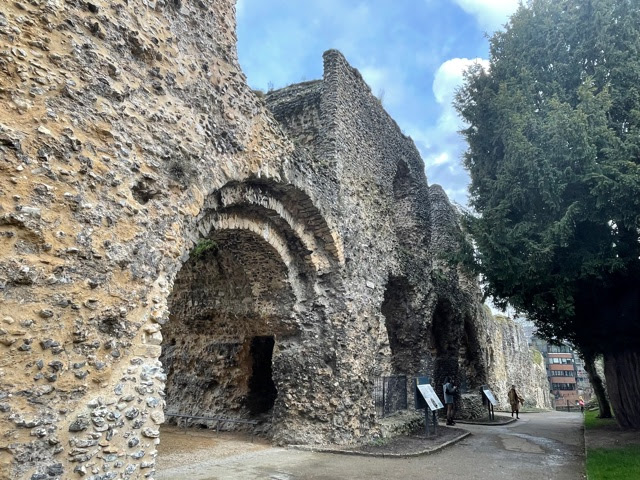In a previous post, I discussed boys' boarding school life at the time of Jane Austen. Have you ever wondered what life was like for school girls in Georgian times? In this post, I will tell you more about girls' boarding school life, having re-visited Jane Austen's school in Reading.
You may already have read my previous blog about Jane Austen's schooling here at Reading and my previous visit to the Abbey Gateway and Reading Abbey. This year, marking 250 years since the birth of Jane Austen, many towns in the UK have been celebrating her life, and Reading is no exception. Reading Museum has hosted a series of talks about Jane Austen this spring/summer, and I recently attended a talk about her education by Jane Austen Society member, Joy Pibworth, at the Reading Abbey Gateway where Jane briefly went to school.
It was very interesting to have a closer look at what Jane's classroom may have looked like and to hear what Joy Pibworth had to say about Jane's "Scrambling Into a Little Education". We learnt that Jane went to boarding school three times. She first went to school at the age of seven in Oxford in 1783. Jane, Cassandra and their cousin, Jane Cooper, only stayed there for six months until their school mistress, Mrs Cawley, moved her school to Southampton due to a measles outbreak in Oxford. However, this experience was short-lived, as soldiers brought with them an outbreak of typhus, and all the three girls caught the illness and were rescued and brought home by Mrs Cooper (who, sadly, later died of the illness).
After some time, the Austens started looking for a new boarding school for the girls. Joy Pibworth explained that it was Jane Cooper's father, Rev. Cooper, who was then Vicar of Sonning, who managed to find a new school for the girls in 1785 when Jane was ten years old. Mrs Latournelle's Reading Ladies' Boarding School was advertised in the Reading Mercury newspaper, as was customary at the time. The Austens thought this a good idea, as Rev Cooper lived nearby, and Jane's aunt and uncle, the Leigh Perrots, lived in Wargrave and could help look after the girls. Jane stayed here from 1785 to 1786.
Mrs Latournelle wasn't actually French despite her fine name; her name was originally Sarah Hackit, but she used a French name to attract parlour boarders. According to Joy Pibworth, Mrs Latournelle was an eccentric personality who wore traditional clothes and had a "cork leg", i.e. a false leg acquired from Cork Street in London. Her school had a good reputation, and she didn't have to advertise her school much although she owned two (the other one being in Henley, not far from Reading).
The Abbey Gateway was an attractive gothic style building with gilt balustrades and many nooks and crannies. In true Georgian style, weeds were encouraged to grow through the bricks allowing for a more romantic look.
Gothic style windows.
Jane's father paid 37 pounds 19 shillings (roughly the equivalent of 3400 pounds in today's money) per girl per half year. This amount included board, tuition, learning materials and having their clothes washed.
The girls were grouped by knowledge rather than age, just like it was customary in the boys' school. The girls attended lessons in the Gateway, and their living quarters were in the building next door to the Gateway built in Queen Anne style (but no longer there). The girls shared bedrooms, and Joy Pibworth explained that there were 4-6 beds in each bedroom. There were 40 bedsteads in the school, giving us an idea of the number of parlour boarders at the school.
There was a beautiful, old-fashioned garden with tall trees where the girls could spend their evenings after lessons and an artificial embankment from where you could watch the ruins of the abbey.
I believe that studying in a Gothic building and living in such close quarters to a medieval abbey had a profound influence on young Jane Austen and perhaps inspired her when writing Northanger Abbey later in life.
As Reading Museum has started offering tours of the Reading Abbey Gateway to schoolchildren, the building has been done up to resemble a Victorian-style girls' boarding school classroom.
In the mornings, after breakfast, the girls would have their lessons in the Gateway, learning sewing, reading and writing and perhaps some French.
It is believed that Jane created Mrs Goddard's school in Emma based on her experience of Mrs Latournelle's school. Jane Austen describes Harriet Smith's school as 'A real old-fashioned Boarding School where a reasonable quantity of accomplishments were sold at a reasonable price and girls might be out of the way and scramble themselves into a little education without any danger of coming back prodigies'. This was Jane's way of saying that the girls learnt a little bit of this and that, but nothing much of value!
After 18 months, Jane's time at Reading came to an end, and the girls were sent home to be educated there. Perhaps the schooling became too expensive and wasn't considered that important for the girls. Luckily, Jane had access to her father's excellent library and read widely, wrote stories from an early age and only had tuition for music and other special skills from home. Mrs Latournelle's school was later sold and became St Quentin's Grammar School.
Many thanks to Jo Pibworth and Reading Museum for an informative afternoon and for the wonderful opportunity to visit Jane Austen's classroom.
Further reading:
















No comments:
Post a Comment
Would love for you to add some valuable comments and feedback!